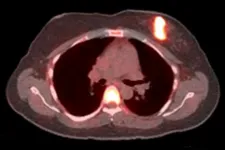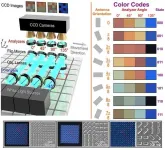(Press-News.org) Toronto, ON - Results of a multi-centre, international, clinical trial co-led by Peter Munk Cardiac Centre (PMCC) cardiologist Dr. Dinesh Thavendiranathan point to the benefit of using a more sensitive test to detect heart function issues early, so cancer patients don't have to fight heart failure too.
Unfortunately, for 1 in 20 high-risk patients, treating cancer with certain therapies means the added potential of developing heart failure. The one-year results of the highly anticipated trial compared heart function at the end of anthracycline-based chemotherapy, a treatment that can successfully treat cancer but also damage the heart, known as cardiotoxicity.
"When I was diagnosed, I was scared for my life," says Sindhu Johnson, a breast cancer patient and one of 307 participants, 90% of which had breast cancer, enrolled in the trial.
"I was willing to undertake any treatment, but I understood my survival may come at a price. And that price included cardiotoxicity."
Dr. Thavendiranathan is the lead of the Cardiotoxicity Prevention Program at the Ted Rogers Centre for Heart Research at the PMCC and a recognized leader in cardiotoxicity.
"We hoped our study would show a better way to care for cancer patients, who are already fighting one disease and should not have to worry about the future risk of heart failure too," says Dr. Thavendiranathan.
Trial participants were split into two groups and monitored during their cancer treatment. One group received the current standard of care, measuring Left Ventricular Ejection Fraction (LVEF) with traditional imaging technology known as echocardiography. The other group received the current standard of care as well as an additional imaging method, measuring Global Longitudinal Strain (GLS).
LVEF measures how much blood is pumped out of the left ventricle of the heart with each contraction, whereas GLS measures deformation of the heart muscle.
"LVEF is the traditional imaging method, but we already know measuring GLS allows for a better identification of heart damage," says Dr. Thavendiranathan. "What we didn't know is if we can reduce the risk of cardiotoxicity by intervening once this early heart damage is detected."
Published in the Journal of the American College of Cardiology, the "Strain Surveillance of Chemotherapy for Improving Cardiovascular Outcomes" (SUCCOUR) randomized controlled trial did not meet its primary outcome, as there was no difference in the continuous measure of heart function for all patients in the LVEF-guided and GLS-guided arms in both treated and untreated patients.
However, what's of clinical importance are the patients whose abnormal change in heart function resulted in the initiation of therapy.
In these patients, the use of GLS-monitoring led to a lower reduction in heart function versus traditional monitoring. It also reduced the risk of cardiotoxicity, and heart damage was detected earlier and in twice the number of participants.
For oncologists and cardiologists, one of the primary concerns is how to prevent the development of cardiotoxicity in patients. The secondary outcome of the SUCCOUR trial proves by using GLS to monitor heart function and intervening with cardioprotective therapy when damage is detected, further reduction in heart function can be prevented and the risk of cardiotoxicity reduced.
"The purpose of a sensitive method like GLS is to pick up the presence of disease and treat it early," says Dr. Thavendiranathan. "This means more patients will be treated, and if we start heart medications when a change is identified, we can prevent significant worsening of heart function."
Sindhu, who was randomized into the GLS arm, joined the SUCCOUR trial knowing it may reduce the degree of cardiotoxicity she could potentially develop.
When a change in measurement alerted Dr. Thavendiranathan that the cancer therapy was damaging her heart, he initiated cardio-protective therapy - drugs that help improve heart function and prevent further damage.
By the end of her treatment, Sindhu's heart function returned to normal and she did not develop cardiotoxicity.
"Our findings suggest we should consider changing how we follow patients during cancer therapy and add GLS to routine heart surveillance," says Dr. Thavendiranathan, who co-led the study at 28 centres with Dr. Thomas Marwick of the Baker Heart and Diabetes Institute, and Dr. Tomoko Negishi of the Menzies Research Institute.
Dr. Thavendiranathan would like to see the GLS-measurement approach implemented in clinical practice.
"This trial gave me hope, and I'm thankful to say I'm now doing well and the cancer treatment worked," says Sindhu. "Dr. Thavendiranathan is an excellent physician and researcher, and I'm very thankful to him."
INFORMATION:
Dr. Thavendiranathan is supported by the Ted Rogers Centre for Heart Research and other donors to Toronto General & Western Hospital Foundation, the Canadian Institutes of Health Research New Investigator Award, the Ontario Early Research Award, and a Canada Research Chair in Cardio-oncology.
The SUCCOUR trial is made possible through the support of the Princess Margaret Cancer Centre at the University Health Network.
Media Contact
Rosa Kim
Senior Public Affairs Advisor
Phone: 647 669 8416
Email: Rosa.kim@uhn.ca
About the Peter Munk Cardiac Centre
The Peter Munk Cardiac Centre, established through the generous support of The Peter and Melanie Munk Charitable Foundation, is the premier cardiac centre in Canada. Each year, over 163,000 patients receive innovative and compassionate care from a multidisciplinary team who treat some of the most complex cases of heart and vascular disease. Our clinical and research expertise has improved the lives of patients around the world, while we continue to train more cardiologists, cardiovascular surgeons, and vascular surgeons than any other hospital in Canada. The Peter Munk Cardiac Centre is based at Toronto General Hospital, Toronto Western Hospital and Toronto Rehabilitation Institute - all members of University Health Network. For more information, visit http://www.petermunkcardiaccentre.ca
About the University Health Network
University Health Network consists of Toronto General, recently voted one of the Top 5 Hospitals in the World according to Newsweek Magazine, and Toronto Western Hospital, the Princess Margaret Cancer Centre, Toronto Rehabilitation Institute, and the Michener Institute of Education at UHN. The scope of research and complexity of cases at University Health Network has made it a national and international source of discovery, education and patient care. It has the largest hospital-based research program in Canada, with major research in cardiology, transplantation, neurosciences, oncology, surgical innovation, infectious diseases, genomic medicine and rehabilitation medicine. University Health Network is a research hospital affiliated with the University of Toronto.
DALLAS, Feb. 2, 2021 — Young, Black adults are more than twice as likely to die in the first year after a heart transplant when compared to same-age, non-Black heart transplant recipients, according to new research published today in Circulation: Heart Failure, an American Heart Association journal.
Research has consistently shown that Black heart transplant recipients have a higher risk of death following heart transplantation compared to non-Black recipients. Black patients have higher prevalence of cardiovascular disease at younger ages, and therefore, they may need heart transplants at younger ...
Hormone therapy commonly is given as a targeted treatment for women whose cancer cells carry receptors for estrogen. But the therapy only works for about half of all patients. Until now, there hasn't been a good way to reliably predict who will benefit and who will not.
Researchers at Washington University School of Medicine in St. Louis have shown they can distinguish patients likely or unlikely to benefit from hormone therapy using an imaging test that measures the function of the estrogen receptors in their cancer cells. In a small phase 2 clinical trial, the researchers showed that the cancers of all patients with working estrogen receptors remained stable or improved on hormone therapy, and progressed in all women with nonfunctional ...
A new method for constructing special solar cells could significantly increase their efficiency. Not only are the cells made up of thin layers, they also consist of specifically arranged nanoblocks. This has been shown in a new study by an international research team led by the Martin Luther University Halle-Wittenberg (MLU), which was published in the scientific journal Nano Letters.
Commercially available solar cells are mostly made of silicon. "Based on the properties of silicon it's not feasible to say that their efficiency can be increased indefinitely," says Dr Akash Bhatnagar, a physicist from the Centre for Innovation Competence (ZIK) "SiLi-nano" at MLU. ...
CHARLOTTESVILLE, VA (FEBRUARY 2, 2021). Researchers in the United Kingdom (UK) conducted a randomized controlled trial in 47 patients with lumbar spinal stenosis to compare treatment outcomes and costs of two competing surgical procedures: insertion of the X-Stop® (Medtronic) interspinous distractor device and open decompression surgery with laminectomy. Both procedures improved the patients' quality of life; however, overall, laminectomy gave patients a better quality of life and was also more cost-effective.
Detailed findings of this study can be found in a new article, "A randomized controlled trial of the X-Stop interspinous ...
Abu Dhabi, UAE, February 2, 2021: Adolescent mothers often fall through the cracks of educational programming. This is highly problematic given that globally an estimated 12 million girls between the ages of 15-19, and 777,000 girls under the age of 15, give birth each year. In populations affected by conflict and displacement, adolescent girls have an increased likelihood of becoming mothers due to various factors, such as disruptions to schooling, the loss of family members, poverty, gender-based violence, and poor access to healthcare and sexual and reproductive services and resources. There is a lack of support programs for these young mothers, and a continuing need for educational programming. ...
Temperature rise due to climate change has negatively affected labour productivity in the past decades and will keep damaging it, potentially at a higher extent than what has been estimated in the literature up to now. In South Africa, a future scenario with severe climate change will feature a reduction of per capita GDP of up to 20% by the end of the century, compared to an idealized future without the impacts of a changing climate.
This is what emerges from the study "Climate change and development in South Africa: the impact of rising temperatures on economic productivity and labour availability", coordinated by the ...
Many household products contain ingredients to protect them against sun damage. These UV filters are found in plastics, paints and textiles, as well as personal care products such as sunscreens and moisturizers. UV filters are entering the aquatic environment in rivers, lakes and oceans. Consider for a moment a beach goer swimming in the ocean or rain washing over plastic playground equipment and running into a stormwater drain - either directly or indirectly, UV filters end up making their way to a waterway.
UV filters are chemicals that work by either physically blocking or absorbing UV rays. There are two main types of UV filters: inorganic forms, which contain metal particles, ...
WEST LAFAYETTE, Ind. - Purdue University innovators have created technology aimed at replacing Morse code with colored "digital characters" to modernize optical storage. They are confident the advancement will help with the explosion of remote data storage during and after the COVID-19 pandemic.
Morse code has been around since the 1830s. The familiar dots and dashes system may seem antiquated given the amount of information needed to be acquired, digitally archived and rapidly accessed every day. But those same basic dots and dashes are still used in many optical media to aid in storage.
A new technology developed at Purdue is aimed at ...
As the U.S. confronts a bitter election season, political unrest and violence, a shaky economy, and a soaring death toll due to COVID-19, 84% of U.S. adults say the country has serious societal issues that we need to address, according to a new poll.
At the same time, 9 in 10 adults say they hope that the country moves toward unity, according to Stress in AmericaTM: January 2021 Stress Snapshot, conducted by The Harris Poll on behalf of the American Psychological Association.
The survey found that the average reported stress level during the prior month was 5.6, (on a scale from 1 to 10 where ...
ARLINGTON HEIGHTS, IL (Feb. 2, 2021) - As the number of states increase where medical and recreational cannabis use is legal, so does the importance that physicians discuss with patients the effects of cannabis on those with asthma. A new survey in Annals of Allergy, Asthma and Immunology, the scientific journal of the American College of Allergy, Asthma and Immunology, shows that of those who used cannabis, about half smoked it while a third vaped - both "inhalation routes" likely to affect one's lungs.
"It surprised me that over half of the cannabis users in this study who have asthma were smoking it," said Joanna Zeiger, PhD, principal investigator for the study. "And further, of those with uncontrolled asthma, ...





